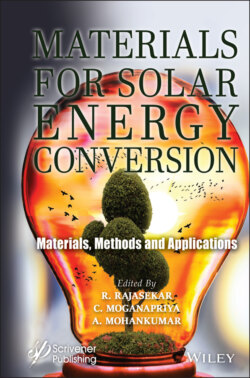Читать книгу Materials for Solar Energy Conversion - Группа авторов - Страница 54
2.4.2 Dye Sensitized PV Cell
ОглавлениеIt consists of transparent conducting glass, titanium oxide (TiO2) nanoparticles, dyes, electrodes, and counter electrode as shown in Figure 2.7. Glass substrate layer is in the top, which permits sunlight into the cell simultaneously conducting electrons transfer to external circuit. Titanium oxide nanoparticles are used as anode materials also called negatively doped; it has high photosensitivity and stability. Dye molecules are very important for increasing efficiency through absorbing visible light photons. Natural colorings and synthetic dyes act as donor and acceptor, respectively, which enhance current density and absorbing capacity of infrared region. Three different kinds of electrolytes have been used for the PV cells, namely, inorganic solvents, inorganic ionic liquids produced with salt or mixure salts, and solid electrolyte such as iodine free gel electrolyte. In the backside of dye sensitized cell, another glass substrate is covered by platinum as catalyst and produces cathode materials. It is very low expensive and more appropriate to a thin film solar cell group [19]. Working of dye sensitized PV cells is based on semiconductor that is devised between an electrode and photo sensitized anode in electrochemical system. The advanced dye solar PV cell is also called Gratzel cell, which is invented by B.O’Reganand and M.Gratzel at UC Berkeley in 1988 [4]. Later, it has been developed by scientist at Ecole Polytechnique, Lausanne in 1991 [14]. In 2010, M. Gratzel has honored with Millennium Technology prize for this innovation [20]. This type of cells has more advantages compared to other type of cells, which are cost effective, flexible, and transparent. It has been avoided number of high cost materials such as ruthenium and platinum. Presence of liquid electrolyte makes difficulty in terms of making appropriate in all weather conditions. However, its power conversion efficiency is low compared to other high expensive solar cells. The efficiency of this system should be high than only it can compete with commercially available solar cells.
Figure 2.6 Copper zinc tin sulfide PV cell.
Figure 2.7 Dye sensitized PV cell.
